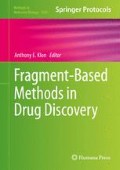Abstract
Hydration has a significant impact on ligand binding within protein active sites. Specific water molecules and their placement within protein active sites have been shown to make specific contributions to the energetics of protein–ligand binding and need consideration in the design of efficient binding ligands. These specific nonbulk water molecules and their interactions are different and have more significant impact in ligand design than the generalized bulk solvation of ligand–protein systems. Proper theoretical description of the solvation effects of water within a ligand-binding pocket is a significant computational challenge. Recently, new computational methods have been developed which can more accurately describe the contribution of waters within a protein ligand site and lead to improved and enhanced ligand design and ranking in computational docking and to greater enrichment.
Access this chapter
Tax calculation will be finalised at checkout
Purchases are for personal use only
Abbreviations
- RISM:
-
Reference interaction site model
- IFST/IST:
-
Inhomogeneous fluid solvation theory
- HFE:
-
Hydration free energy
- MM-PB/SA:
-
Molecular mechanics-poisson-boltzmann/surface area
- MM-GB/SA:
-
Molecular mechanics-generalized born method/surface area
- FEP:
-
Free energy perturbation
- TIP:
-
Transferable interaction potential
- MD:
-
Molecular dynamics
- IETs:
-
Integral equation theories
References
Jorgensen WL, Chandrasekhar J, Madura JD, Impey RW, Klein ML (1993) Comparison of simple potential functions for simulating liquid water. J Chem Phys 79:926–935
Toukan K, Rahman A (1985) Molecular-dynamics study of atomic motions in water. Phys Rev B 31:2643–2648
Kästner J, Senn HM, Thiel S, Otte N, Thiel W (2006) QM/MM free-energy perturbation compared to thermodynamic integration and umbrella sampling: application to an enzymatic reaction. JCTC 2 2:452–461
Lazaridis T (1998) Inhomogeneous fluid approach to solvation thermodynamics. 1. Theory. J Phys Chem B 102:3531–3541
Young T, Abel R, Kim B, Berne BJ, Friesner RA (2007) Motifs for molecular recognition exploiting hydrophobic enclosure in protein-ligand binding. Proc Natl Acad Sci U S A 104:808–813
Abel R, Young T, Farid R, Berne BJ, Friesner RA (2008) Role of the active-site solvent in the thermodynamics of factor Xa ligand binding. J Am Chem Soc 130:2817–2831
Nguyen CN, Young TK, Gilson MK (2012) Grid inhomogeneous solvation theory: hydration structure and thermodynamics of the miniature receptor cucurbit [7] uril. J Chem Phys 137:044101–044117
Beuming T, Che Y, Abel R, Kim B, Shanmugasundaram V, Sherman W (2012) Themodynamic analysis of water molecules at the surface of proteins and applications to binding site prediction and characterization. Proteins 80:871–883
Kuhn B, Kollman PA (2000) A ligand that is predicted to bind better to avidin than biotin: insights from computational fluorine scanning. J Am Chem Soc 122:3909–3916
Guimaraes CRW, Cardozo M (2008) MM-GB/SA resourcing of docking poses in structure-based lead optimization. J Chem Inf Model 48:958–970
SZMAP 1.2.0.7: OpenEye Scientific Software, Santa Fe, NM. http://www.eyesopen.com. (2013)
Truchon JF, Pettitt BM, Labute P (2014) A cavity corrected 3D-RISM functional for accurate solvation free energies. J Chem Theory Comput 10:934–941
Sindhikara DJ, Hirata F (2013) Analysis of biomolecular solvation sites by 3D-RISM theory. J Phys Chem B 117:6718–6723
Cui G, Swails JM, Manas ES (2013) SPAM: a simple approach for profiling bound water molecules. J Chem Theory Comput 9:5539–5549
Sindhikara DJ, Yoshida N, Hirata F (2012) An algorithm for prediction of explicit solvent atom distribution—application to HIV-1 protease and F-ATP synthase. J Comput Chem 33:1536–1543
Kumari R, Kumar R, Open Source Drug Discovery Consortium, Lynn A (2014) g_mmpbsa—a GROMACS tool for high-throughput MM-PBSA calculations. J Chem Inf Model 54:1951–1962
Liu J, He X, Zhang JZH (2013) Improving the scoring of protein−ligand binding affinity by including the effects of structural water and electronic polarization. J Chem Inf Model 53:1306–1314
Kawatkar S, Moustakas D, Miller M, Joseph-McCarthy D (2012) Virtual fragment screening: exploration of MM-PBSA re-scoring. J Comput Aided Mol Des 26:921–934
Author information
Authors and Affiliations
Corresponding author
Editor information
Editors and Affiliations
Rights and permissions
Copyright information
© 2015 Springer Science+Business Media New York
About this protocol
Cite this protocol
Bienstock, R.J. (2015). Solvation Methods for Protein–Ligand Docking. In: Klon, A. (eds) Fragment-Based Methods in Drug Discovery. Methods in Molecular Biology, vol 1289. Humana Press, New York, NY. https://doi.org/10.1007/978-1-4939-2486-8_1
Download citation
DOI: https://doi.org/10.1007/978-1-4939-2486-8_1
Published:
Publisher Name: Humana Press, New York, NY
Print ISBN: 978-1-4939-2485-1
Online ISBN: 978-1-4939-2486-8
eBook Packages: Springer Protocols

